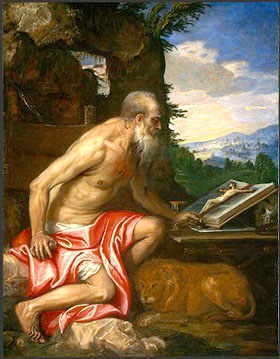
Feastday: September 30
Patron: of archaeologists, Biblical scholars, librarians, students and translators
Birth: 342
Death: 420
Before he was known as Saint Jerome, he was named Eusebius Sophronius Hieronymus. He was born around 342 AD, in Stridon, Dalmatia. Today, the town, which ceased to exist in Jerome's time, would likely be in Croatia or Slovenia.
The young Jerome was educated by Aelius Donatus, who was a famous Roman grammarian. From him, the young Jerome learned Latin and Greek. Little else is known of his childhood other than his parents were probably well-to-do and Christian. Despite their efforts to raise Jerome properly, the young man behaved as he chose.
Around the age of 12 or so, Jerome traveled to Rome to study grammar, philosophy and rhetoric. It is likely that due to his training in rhetoric, he may have considered a career in law. By his own admission, he quickly forgot his morals. While he was not studying, Jerome pursued pleasure. In particular, he pursued women, even though he knew his behavior was wrong.
To alleviate the feelings of guilt he often felt afterwards, Jerome would visit the crypts in Rome and imagine himself in hell. He did so every Sunday, even though he was not a Christian. Jerome succeeded in frightening himself, but not in changing his ways.
Fortunately, Jerome had as a companion, Bonosus, who was a Christian influence. His influence is part of what persuaded Jerome to become a Christian and change his ways for the better.
In or around the year 366, Jerome decided to become a Christian and was baptized by Pope Liberius.
Now interested in theological matters, Jerome set aside secular matters to pursue matters of the faith. He traveled with Bonosus to Trier where there were schools for him to gain ecclesiastical training.
In 370, he traveled close to home, ending up in a monastery at Aquileia. The monastery was overseen by Bishop St. Valerian, who had attracted some of the greatest minds in Christendom. While in Aquileia, Jerome met Rufinus and the two men became friends. Rufinis was a monk who became renown for his translations of Greek works into Latin. Jerome himself was developing his skills as a translator, a skill he developed during his time in the Roman catacombs, translating the inscriptions on the tombs.
Following his time in Aquileia, Jerome traveled next to Treves, Gaul where he began to translate books for his own use. His goal was to build a personal library.
After a time in Gaul, he returned to Aquileia in 373. While there, Jerome and his friend Bonosus had a falling out and decided to part ways. Bonosus departed for an island in the Adriatic where he would live as a hermit for a time.
Jerome traveled to the east, bound for Antioch by way of Athens.
In 374, Jerome finally reached Antioch, after making several lengthy stops along the way. While in that city, Jerome began writing his first work, "Concerning the Seven Beatings."
During that same year, disease made Jerome ill while taking the lives of some of his companions. It is unclear what disease was responsible, or if different illnesses had taken his friends. During his illness, Jerome had visions which made him even more religious.
Jerome went into the desert to live for four years, living as a hermit southwest of Antioch. He was frequently ill during this time.
After he emerged from his hermitage, Jerome was quickly embroiled in conflicts within the Church at Antioch. This was not something Jerome wanted to be associated with. Jerome made clear that he did not want to become a priest, preferring instead to be a monk or a hermit. But Church officials in Antioch as well as Pope Damasus wanted him to be ordained. Jerome relented on the condition he would not be expected to serve in any ministry and would still be allowed to pursue his monastic life. He was subsequently ordained.
Making the most of his freedom as a priest, Jerome traveled to Constantinople where he studied under St. Gregory of Nazianzus, who was renown as a great theologian.
After St. Gregory left Constantinople in 382, Jerome traveled to Rome for a council of the Church and met Pope Damasus. Following the council, Pope Damsus kept Jerome in Rome and made him his secretary.
While serving as secretary to the pope, Jerome also promoted the ideal of asceticism to everyone around him. Included in this group were women of the city of Rome who wanted to live saintly lives.
Pope Damasus died in 384, and this exposed Jerome to criticism and controversy. Jerome was a sarcastic man of great wit. He became unpopular because of his attitude and made a number of enemies. While Pope Damasus was alive, he could shield Jerome from criticism, but now Jerome faced the vengeance of the enemies he made. Both prominent pagans who resented his promotion of the faith and fellow Christians who lacked his wit attacked him with vicious rumors. Among the rumors were accusations that he was behaving inappropriately with the woman we now know as Paula. At that time, she was one of his students in asceticism.
Paula was a widow with four children who deeply mourned the loss of her husband. Jerome provided counseling and instruction to her and she became a lifelong friend and follower of Jerome, assisting him in his work.
Eventually, Jerome decided to return to the Holy Land to escape the calumny in Rome. He headed east and arrived in Antioch in 386. Shortly after, Jerome was met by Paula, her daughter, and several other followers. The group went first to Jerusalem, then on to Alexandria, Egypt. They settled in Bethlehem and had a monastery built there which included dormitories for women.
Jerome was a hard worker and he wrote extensively defending the virginity of Mary, which some clerics dared to question. He also engaged in several debates against various other heresies including a lengthy battle with his old friend Rufinus. Jerome was easily upset, and even the venerable St. Augustine exchanged words with him. Eventually, Jerome and Augustine repaired their relationship and were able to correspond as friends and colleagues.
Of all the things that made Jerome famous, nothing was so legendary as his translation of the Bible. Jerome began work while he was still in Rome under Pope Damasus. He spent his entire life translating the scriptures from Hebrew and Old Latin.
In the year 404 Paula died, later to become a saint of the Church. Rome was sacked by Alarc the Barbarian in 410. These events distressed Jerome greatly. Violence eventually found its way to Bethlehem disrupting Jerome's work in his final years.
Jerome died on September 30, 420. His death was peaceful and he was laid to rest under the Church of the Nativity. His remains were later transferred to Rome.
Saint Jerome is the patron saint of archaeologists, Biblical scholars, librarians, students and translators.
His feast day is September 30.
This article is about the priest and Bible translator. For other uses, see Jerome (disambiguation) and Saint Jerome (disambiguation). 4th and 5th-century Catholic priest, theologian, and saint
| Part of a series on |
| Catholic philosophy |
|---|
   Aquinas, Scotus, and Ockham Aquinas, Scotus, and Ockham |
| Ethics |
|
| Schools |
|
| Philosophers |
Ancient
|
Postclassical
|
Modern
|
Contemporary
|
|
|
|
Jerome (/dʒəˈroʊm/; Latin: Eusebius Sophronius Hieronymus; Greek: Εὐσέβιος Σωφρόνιος Ἱερώνυμος; c. 342–347 – 30 September 420), also known as Jerome of Stridon, was a Latin priest, confessor, theologian, and historian; he is commonly known as Saint Jerome.
Jerome was born at Stridon, a village near Emona on the border of Dalmatia and Pannonia. Jerome is best known for his translation of most of the Bible into Latin (the translation that became known as the Vulgate) and his commentaries on the whole Bible. Jerome attempted to create a translation of the Old Testament based on a Hebrew version, rather than the Septuagint, as Latin Bible translations used to be performed before him. His list of writings is extensive, and beside his biblical works, he wrote polemical and historical assays, always from a theologian's perspective.
Jerome was known for his teachings on Christian moral life, especially to those living in cosmopolitan centers such as Rome. In many cases, he focused his attention on the lives of women and identified how a woman devoted to Jesus should live her life. This focus stemmed from his close patron relationships with several prominent female ascetics who were members of affluent senatorial families.
Thanks to Jerome's contribution to Christianity, he is recognised as a saint and Doctor of the Church by the Catholic Church, the Eastern Orthodox Church, the Lutheran Church, and the Anglican Communion. His feast day is 30 September.
Life
Eusebius Sophronius Hieronymus was born at Stridon around 342–347 AD. He was of Illyrian ancestry, although whether he was able to speak the Illyrian language is a subject of controversy. He was not baptized until about 360–369 in Rome, where he had gone with his friend Bonosus of Sardica to pursue rhetorical and philosophical studies. (This Bonosus may or may not have been the same Bonosus whom Jerome identifies as his friend who went to live as a hermit on an island in the Adriatic.) Jerome studied under the grammarian Aelius Donatus. There he learned Latin and at least some Greek, though he probably did not yet acquire the familiarity with Greek literature that he later claimed to have acquired as a schoolboy.
As a student, Jerome engaged in the superficial escapades and sexual experimentation of students in Rome; he indulged himself quite casually but he suffered terrible bouts of guilt afterwards. To appease his conscience, on Sundays he visited the sepulchers of the martyrs and the Apostles in the catacombs. This experience reminded him of the terrors of hell:
Often I would find myself entering those crypts, deep dug in the earth, with their walls on either side lined with the bodies of the dead, where everything was so dark that almost it seemed as though the Psalmist's words were fulfilled, Let them go down quick into Hell. Here and there the light, not entering in through windows, but filtering down from above through shafts, relieved the horror of the darkness. But again, as soon as you found yourself cautiously moving forward, the black night closed around and there came to my mind the line of Virgil, "Horror ubique animos, simul ipsa silentia terrent".
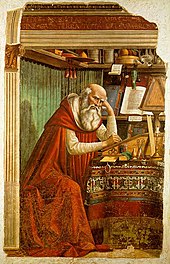 St. Jerome in His Study (1480), by Domenico Ghirlandaio.
St. Jerome in His Study (1480), by Domenico Ghirlandaio.
His quote from Virgil reads: "On all sides round horror spread wide; the very silence breathed a terror on my soul"—to describe the horror of hell. He initially used classical authors to describe Christian concepts such as hell that indicated both his classical education and his deep shame of their associated practices, such as the pederasty then found in Rome.
Conversion to Christianity
 St Jerome in the Nuremberg Chronicle
St Jerome in the Nuremberg Chronicle
Although initially skeptical of Christianity, he eventually converted. After several years in Rome, he travelled with Bonosus to Gaul and settled in Trier where he seems to have first taken up theological studies, and where, for his friend Tyrannius Rufinus, he copied Hilary of Poitiers' commentary on the Psalms and the treatise De synodis. Next came a stay of at least several months, or possibly years, with Rufinus at Aquileia, where he made many Christian friends.
Some of these accompanied Jerome when in about 373 he set out on a journey through Thrace and Asia Minor into northern Syria. At Antioch, where he stayed the longest, two of his companions died and he himself was seriously ill more than once. During one of these illnesses (about the winter of 373–374), he had a vision that led him to lay aside his secular studies and devote himself to God. He seems to have abstained for a considerable time from the study of the classics and to have plunged deeply into study of the Bible, under the impulse of Apollinaris of Laodicea, then teaching in Antioch and not yet suspected of heresy.
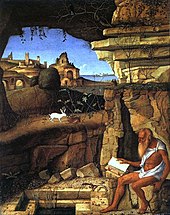 St. Jerome in the Desert, by Giovanni Bellini (1505)
St. Jerome in the Desert, by Giovanni Bellini (1505)
Seized with a desire for a life of ascetic penance, Jerome went for a time to the desert of Chalcis, to the southeast of Antioch, known as the "Syrian Thebaid" from the number of eremites inhabiting it. During this period, he seems to have found time for studying and writing. He made his first attempt to learn Hebrew under the guidance of a converted Jew; and he seems to have been in correspondence with Jewish Christians in Antioch. Around this time he had copied for him a Hebrew Gospel, of which fragments are preserved in his notes. It is known today as the Gospel of the Hebrews which the Nazarenes considered to be the true Gospel of Matthew. Jerome translated parts of this Hebrew Gospel into Greek.
Returning to Antioch in 378 or 379, Jerome was ordained there by Bishop Paulinus, apparently unwillingly and on condition that he continue his ascetic life. Soon afterward, he went to Constantinople to pursue a study of Scripture under Gregory Nazianzen. He seems to have spent two years there, then left, and for the next three (382–385) he was in Rome again, as secretary to Pope Damasus I and the leading Roman Christians. Invited originally for the synod of 382, held to end the schism of Antioch as there were rival claimants to be the proper patriarch in Antioch. Jerome had accompanied one of the claimants, Paulinus, back to Rome to get more support for him; Jerome distinguished himself before the pope and assumed a prominent place in his papal councils.
As protege of the pope Damasus, Jerome was given duties in Rome, and he undertook a revision of the Latin Bible based on the Greek manuscripts of the New Testament. He also updated the Psalter containing the Book of Psalms then in use in Rome, based on the Septuagint. Though he did not realize it yet, translating much of what became the Latin Vulgate Bible would take many years and be his most important achievement (see Writings – Translations section below).
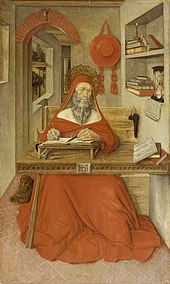 Saint Jerome in His Study, 1451, by Antonio da Fabriano II, shows writing implements, scrolls, and manuscripts testifying to Jerome's scholarly pursuits. The Walters Art Museum.
Saint Jerome in His Study, 1451, by Antonio da Fabriano II, shows writing implements, scrolls, and manuscripts testifying to Jerome's scholarly pursuits. The Walters Art Museum.
In Rome, Jerome was surrounded by a circle of well-born and well-educated women, including some from the noblest patrician families, such as the widows Lea, Marcella and Paula, with Paula's daughters Blaesilla and Eustochium. The resulting inclination of these women towards the monastic life, away from the indulgent lasciviousness in Rome, and his unsparing criticism of the secular clergy of Rome, brought a growing hostility against him among the Roman clergy and their supporters. Soon after the death of his patron Pope Damasus I on 10 December 384, Jerome was forced to leave his position at Rome after an inquiry was brought up by the Roman clergy into allegations that he had an improper relationship with the widow Paula. Still, his writings were highly regarded by women who were attempting to maintain a vow of becoming a consecrated virgin. His letters were widely read and distributed throughout the Christian empire and it is clear through his writing that he knew these virgin women were not his only audience.
Additionally, Jerome's condemnation of Blaesilla's hedonistic lifestyle in Rome had led her to adopt ascetic practices, but it affected her health and worsened her physical weakness to the point that she died just four months after starting to follow his instructions; much of the Roman populace were outraged at Jerome for causing the premature death of such a lively young woman, and his insistence to Paula that Blaesilla should not be mourned, and complaints that her grief was excessive, were seen as heartless, polarising Roman opinion against him.
After Rome
In August 385, Jerome left Rome for good and returned to Antioch, accompanied by his brother Paulinian and several friends, and followed a little later by Paula and Eustochium who had resolved to end their days in the Holy Land. In the winter of 385, Jerome acted as their spiritual adviser. The pilgrims, joined by Bishop Paulinus of Antioch, visited Jerusalem, Bethlehem, and the holy places of Galilee, and then went to Egypt, the home of the great heroes of the ascetic life.
At the Catechetical School of Alexandria, Jerome listened to the catechist Didymus the Blind expounding the prophet Hosea and telling his reminiscences of Anthony the Great, who had died 30 years before. Jerome spent some time in Nitria, admiring the disciplined community life of the numerous inhabitants of that "city of the Lord", but detecting even there "concealed serpents", i.e., the influence of Origen of Alexandria. Late in the summer of 388 he was back in Palestine, and spent the remainder of his life working in a cave near Bethlehem, the very cave where Jesus was born, surrounded by a few friends, both men and women (including Paula and Eustochium), to whom he acted as priestly guide and teacher.
 Saint Jerome in His Study, by Niccolò Antonio Colantonio c. 1445–46, depicts Jerome's removal of a thorn from a lion's paw.
Saint Jerome in His Study, by Niccolò Antonio Colantonio c. 1445–46, depicts Jerome's removal of a thorn from a lion's paw.
Amply provided for by Paula with the means of livelihood and for increasing his collection of books, Jerome led a life of incessant activity in literary production. To these last 34 years of his career belong the most important of his works; his version of the Old Testament from the original Hebrew text, the best of his scriptural commentaries; his catalogue of Christian authors; and the dialogue against the Pelagians, the literary perfection of which even an opponent recognized. To this period also belong most of his polemics, which distinguished him among the orthodox Fathers, including the treatises against the Origenism later declared anathema, of Bishop John II of Jerusalem and his early friend Rufinus. Later, as a result of his writings against Pelagianism, a body of excited partisans broke into the monastic buildings, set them on fire, attacked the inmates and killed a deacon, forcing Jerome to seek safety in a neighboring fortress in 416.
Death
It is recorded that Jerome died near Bethlehem on 30 September 420. The date of his death is given by the Chronicon of Prosper of Aquitaine. His remains, originally buried at Bethlehem, are said to have been later transferred to the basilica of Santa Maria Maggiore in Rome, though other places in the West claim some relics, the cathedral at Nepi boasting possession of his head, which, according to another tradition, is in the Escorial.
Translation of the Bible (382–405)
 Saint Jerome Writing, by Michelangelo Merisi da Caravaggio, 1607, at St John's Co-Cathedral, Valletta, Malta
Saint Jerome Writing, by Michelangelo Merisi da Caravaggio, 1607, at St John's Co-Cathedral, Valletta, Malta
Jerome was a scholar at a time when that statement implied a fluency in Greek. He knew some Hebrew when he started his translation project, but moved to Jerusalem to strengthen his grip on Jewish scripture commentary. A wealthy Roman aristocrat, Paula, funded his stay in a monastery in Bethlehem and he completed his translation there. He began in 382 by correcting the existing Latin-language version of the New Testament, commonly referred to as the Vetus Latina. By 390 he turned to translating the Hebrew Bible from the original Hebrew, having previously translated portions from the Septuagint which came from Alexandria. He believed that the mainstream Rabbinical Judaism had rejected the Septuagint as invalid Jewish scriptural texts because of what were ascertained as mistranslations along with its Hellenistic heretical elements. He completed this work by 405. Prior to Jerome's Vulgate, all Latin translations of the Old Testament were based on the Septuagint, not the Hebrew. Jerome's decision to use a Hebrew text instead of the previous-translated Septuagint went against the advice of most other Christians, including Augustine, who thought the Septuagint inspired. Modern scholarship, however, has sometimes cast doubts on the actual quality of Jerome's Hebrew knowledge. Many modern scholars believe that the Greek Hexapla is the main source for Jerome's "iuxta Hebraeos" (i.e. "close to the Hebrews", "immediately following the Hebrews") translation of the Old Testament. However, detailed studies have shown that to a considerable degree Jerome was a competent Hebraist.
Commentaries (405–420)
 Saint Jerome, unknown Southern Dutch artist, 1520, Hamburger Kunsthalle
Saint Jerome, unknown Southern Dutch artist, 1520, Hamburger Kunsthalle
For the next 15 years, until he died, Jerome produced a number of commentaries on Scripture, often explaining his translation choices in using the original Hebrew rather than suspect translations. His patristic commentaries align closely with Jewish tradition, and he indulges in allegorical and mystical subtleties after the manner of Philo and the Alexandrian school. Unlike his contemporaries, he emphasizes the difference between the Hebrew Bible "Apocrypha" and the Hebraica veritas of the protocanonical books. In his Vulgate's prologues, he describes some portions of books in the Septuagint that were not found in the Hebrew as being non-canonical (he called them apocrypha); for Baruch, he mentions by name in his Prologue to Jeremiah and notes that it is neither read nor held among the Hebrews, but does not explicitly call it apocryphal or "not in the canon". His Preface to The Books of Samuel and Kings includes the following statement, commonly called the Helmeted Preface:
This preface to the Scriptures may serve as a "helmeted" introduction to all the books which we turn from Hebrew into Latin, so that we may be assured that what is not found in our list must be placed amongst the Apocryphal writings. Wisdom, therefore, which generally bears the name of Solomon, and the book of Jesus, the Son of Sirach, and Judith, and Tobias, and the Shepherd are not in the canon. The first book of Maccabees I have found to be Hebrew, the second is Greek, as can be proved from the very style.
Although Jerome was once suspicious of the Apocrypha, he later viewed them as Scripture. For example, in Jerome's letter to Eustochium he quotes Sirach 13:2; elsewhere Jerome also refers to Baruch, the Story of Susannah and Wisdom as scripture.
 Jerome in the desert, tormented by his memories of the dancing girls, by Francisco de Zurbarán, 1639, Monastery of Santa María de Guadalupe
Jerome in the desert, tormented by his memories of the dancing girls, by Francisco de Zurbarán, 1639, Monastery of Santa María de Guadalupe
Jerome's commentaries fall into three groups:
- His translations or recastings of Greek predecessors, including fourteen homilies on the Book of Jeremiah and the same number on the Book of Ezekiel by Origen (translated c. 380 in Constantinople); two homilies of Origen of Alexandria on the Song of Solomon (in Rome, c. 383); and thirty-nine on the Gospel of Luke (c. 389, in Bethlehem). The nine homilies of Origen on the Book of Isaiah included among his works were not done by him. Here should be mentioned, as an important contribution to the topography of Palestine, his book De situ et nominibus locorum Hebraeorum, a translation with additions and some regrettable omissions of the Onomasticon of Eusebius. To the same period (c. 390) belongs the Liber interpretationis nominum Hebraicorum, based on a work supposed to go back to Philo and expanded by Origen.
- Original commentaries on the Old Testament. To the period before his settlement at Bethlehem and the following five years belong a series of short, Old Testament studies: De seraphim, De voce Osanna, De tribus quaestionibus veteris legis (usually included among the letters as 18, 20, and 36); Quaestiones hebraicae in Genesim; Commentarius in Ecclesiasten; Tractatus septem in Psalmos 10–16 (lost); Explanationes in Michaeam, Sophoniam, Nahum, Habacuc, Aggaeum. After 395 he composed a series of longer commentaries, though in rather a desultory fashion: first on Jonah and Obadiah (396), then on Isaiah (c. 395 – c. 400), on Zechariah, Malachi, Hoseah, Joel, Amos (from 406), on the Book of Daniel (c. 407), on Ezekiel (between 410 and 415), and on Jeremiah (after 415, left unfinished).
- New Testament commentaries. These include only Philemon, Galatians, Ephesians, and Titus (hastily composed 387–388); Matthew (dictated in a fortnight, 398); Mark, selected passages in Luke, Revelation, and the prologue to the Gospel of John.
Historical and hagiographic writings
| This section does not cite any sources. (August 2011) |
 In the Middle Ages, Jerome was often ahistorically depicted as a cardinal.
In the Middle Ages, Jerome was often ahistorically depicted as a cardinal.
Jerome is also known as a historian. One of his earliest historical works was his Chronicon, composed c. 380 in Constantinople; this is a translation into Latin of the chronological tables which compose the second part of the Chronicon of Eusebius, with a supplement covering the period from 325 to 379. Despite numerous errors taken over from Eusebius, and some of his own, Jerome produced a valuable work, if only for the impulse which it gave to such later chroniclers as Prosper, Cassiodorus, and Victor of Tunnuna to continue his annals.
Of considerable importance as well is the De viris illustribus, which was written at Bethlehem in 392, the title and arrangement of which are borrowed from Suetonius. It contains short biographical and literary notes on 135 Christian authors, from Saint Peter down to Jerome himself. For the first seventy-eight authors Eusebius (Historia ecclesiastica) is the main source; in the second section, beginning with Arnobius and Lactantius, he includes a good deal of independent information, especially as to Western writers.
Four works of a hagiographic nature are:
- the Vita Pauli monachi, written during his first sojourn at Antioch (c. 376), the legendary material of which is derived from Egyptian monastic tradition;
- the Vitae Patrum (Vita Pauli primi eremitae), a biography of Saint Paul of Thebes;
- the Vita Malchi monachi captivi (c. 391), probably based on an earlier work, although it purports to be derived from the oral communications of the aged ascetic Malchus of Syria originally made to him in the desert of Chalcis;
- the Vita Hilarionis, of the same date, containing more trustworthy historical matter than the other two, and based partly on the biography of Epiphanius and partly on oral tradition.
The so-called Martyrologium Hieronymianum is spurious; it was apparently composed by a Western monk toward the end of the 6th or beginning of the 7th century, with reference to an expression of Jerome's in the opening chapter of the Vita Malchi, where he speaks of intending to write a history of the saints and martyrs from the apostolic times.
Description of vitamin A deficiency
The following passage, taken from Saint Jerome's "Life of St. Hilarion" which was written about 392, appears to be the earliest account of the etiology, symptoms and cure of severe vitamin A deficiency:
From his thirty-first to his thirty-fifth year he had for food six ounces of barley bread, and vegetables slightly cooked without oil. But finding that his eyes were growing dim, and that his whole body was shrivelled with an eruption and a sort of stony roughness (impetigine et pumicea quad scabredine) he added oil to his former food, and up to the sixty-third year of his life followed this temperate course, tasting neither fruit nor pulse, nor anything whatsoever besides.
Letters
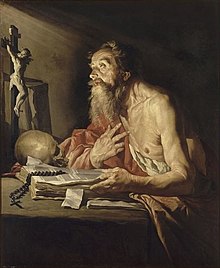 Saint Jerome by Matthias Stom, 1635
Saint Jerome by Matthias Stom, 1635
Jerome's letters or epistles, both by the great variety of their subjects and by their qualities of style, form an important portion of his literary remains. Whether he is discussing problems of scholarship, or reasoning on cases of conscience, comforting the afflicted, or saying pleasant things to his friends, scourging the vices and corruptions of the time and against sexual immorality among the clergy, exhorting to the ascetic life and renunciation of the world, or breaking a lance with his theological opponents, he gives a vivid picture not only of his own mind, but of the age and its peculiar characteristics. Because there was no distinct line between personal documents and those meant for publication, we frequently find in his letters both confidential messages and treatises meant for others besides the one to whom he was writing.
Due to the time he spent in Rome among wealthy families belonging to the Roman upper-class, Jerome was frequently commissioned by women who had taken a vow of virginity to write to them in guidance of how to live their life. As a result, he spent a great deal of his life corresponding with these women about certain abstentions and lifestyle practices. These included the clothing she should wear, the interactions she should undertake and how to go about conducting herself during such interactions, and what and how she ate and drank.
The letters most frequently reprinted or referred to are of a hortatory nature, such as Ep. 14, Ad Heliodorum de laude vitae solitariae; Ep. 22, Ad Eustochium de custodia virginitatis; Ep. 52, Ad Nepotianum de vita clericorum et monachorum, a sort of epitome of pastoral theology from the ascetic standpoint; Ep. 53, Ad Paulinum de studio scripturarum; Ep. 57, to the same, De institutione monachi; Ep. 70, Ad Magnum de scriptoribus ecclesiasticis; and Ep. 107, Ad Laetam de institutione filiae.
 Francesco St Jerome by Jacopo Palma il Giovane, c. 1595
Francesco St Jerome by Jacopo Palma il Giovane, c. 1595
Theological writings
 The Virgin and Child with Saints Jerome and Nicholas of Tolentino by Lorenzo Lotto, 1522
The Virgin and Child with Saints Jerome and Nicholas of Tolentino by Lorenzo Lotto, 1522
Practically all of Jerome's productions in the field of dogma have a more or less vehemently polemical character, and are directed against assailants of the orthodox doctrines. Even the translation of the treatise of Didymus the Blind on the Holy Spirit into Latin (begun in Rome 384, completed at Bethlehem) shows an apologetic tendency against the Arians and Pneumatomachoi. The same is true of his version of Origen's De principiis (c. 399), intended to supersede the inaccurate translation by Rufinus. The more strictly polemical writings cover every period of his life. During the sojourns at Antioch and Constantinople he was mainly occupied with the Arian controversy, and especially the schisms precipitated by Meletius of Antioch and Lucifer Calaritanus. Two letters to Pope Damasus (15 and 16) complain of the conduct of both parties at Antioch, the Meletians and Paulinians, who had tried to draw him into their controversy over the application of the terms ousia and hypostasis to the Trinity. At the same time or a little later (379) he composed his Liber Contra Luciferianos, in which he cleverly uses the dialogue form to combat the tenets of that faction, particularly their rejection of baptism by heretics.
In Rome (c. 383) Jerome wrote a passionate counterblast against the teaching of Helvidius, in defense of the doctrine of the perpetual virginity of Mary and of the superiority of the single over the married state. An opponent of a somewhat similar nature was Jovinianus, with whom he came into conflict in 392 (Adversus Jovinianum, Against Jovinianus) and the defense of this work addressed to his friend Pammachius, numbered 48 in the letters. Once more he defended the ordinary practices of piety and his own ascetic ethics in 406 against the Gallic presbyter Vigilantius, who opposed the cultus of martyrs and relics, the vow of poverty, and clerical celibacy. Meanwhile, the controversy with John II of Jerusalem and Rufinus concerning the orthodoxy of Origen occurred. To this period belong some of his most passionate and most comprehensive polemical works: the Contra Joannem Hierosolymitanum (398 or 399); the two closely connected Apologiae contra Rufinum (402); and the "last word" written a few months later, the Liber tertius seuten ultima responsio adversus scripta Rufini. The last of his polemical works is the skilfully composed Dialogus contra Pelagianos (415).
Eschatology
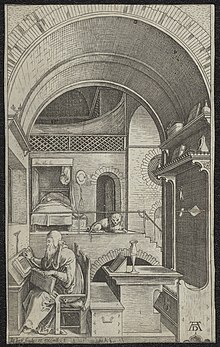 Jerome in his study, made by the Flemish drawer de Bry.
Jerome in his study, made by the Flemish drawer de Bry.
Jerome warned that those substituting false interpretations for the actual meaning of Scripture belonged to the "synagogue of the Antichrist". "He that is not of Christ is of Antichrist," he wrote to Pope Damasus I. He believed that "the mystery of iniquity" written about by Paul in 2 Thessalonians 2:7 was already in action when "every one chatters about his views." To Jerome, the power restraining this mystery of iniquity was the Roman Empire, but as it fell this restraining force was removed. He warned a noble woman of Gaul:
He that letteth is taken out of the way, and yet we do not realize that Antichrist is near. Yes, Antichrist is near whom the Lord Jesus Christ "shall consume with the spirit of his mouth." "Woe unto them," he cries, "that are with child, and to them that give suck in those days."... Savage tribes in countless numbers have overrun run all parts of Gaul. The whole country between the Alps and the Pyrenees, between the Rhine and the Ocean, has been laid waste by hordes of Quadi, Vandals, Sarmatians, Alans, Gepids, Herules, Saxons, Burgundians, Allemanni, and—alas! for the commonweal!—even Pannonians.
His Commentary on Daniel was expressly written to offset the criticisms of Porphyry, who taught that Daniel related entirely to the time of Antiochus IV Epiphanes and was written by an unknown individual living in the second century BC. Against Porphyry, Jerome identified Rome as the fourth kingdom of chapters two and seven, but his view of chapters eight and 11 was more complex. Jerome held that chapter eight describes the activity of Antiochus Epiphanes, who is understood as a "type" of a future antichrist; 11:24 onwards applies primarily to a future antichrist but was partially fulfilled by Antiochus. Instead, he advocated that the "little horn" was the Antichrist:
We should therefore concur with the traditional interpretation of all the commentators of the Christian Church, that at the end of the world, when the Roman Empire is to be destroyed, there shall be ten kings who will partition the Roman world amongst themselves. Then an insignificant eleventh king will arise, who will overcome three of the ten kings. ...After they have been slain, the seven other kings also will bow their necks to the victor.
In his Commentary on Daniel, he noted, "Let us not follow the opinion of some commentators and suppose him to be either the Devil or some demon, but rather, one of the human race, in whom Satan will wholly take up his residence in bodily form." Instead of rebuilding the Jewish Temple to reign from, Jerome thought the Antichrist sat in God's Temple inasmuch as he made "himself out to be like God."
Jerome identified the four prophetic kingdoms symbolized in Daniel 2 as the Neo-Babylonian Empire, the Medes and Persians, Macedon, and Rome. Jerome identified the stone cut out without hands as "namely, the Lord and Savior".
Jerome refuted Porphyry's application of the little horn of chapter seven to Antiochus. He expected that at the end of the world, Rome would be destroyed, and partitioned among ten kingdoms before the little horn appeared.
Jerome believed that Cyrus of Persia is the higher of the two horns of the Medo-Persian ram of Daniel 8:3. The he-goat is Greece smiting Persia. Alexander is the great horn, which is then succeeded by Alexander's half brother Philip and three of his generals.
Reception by later Christianity
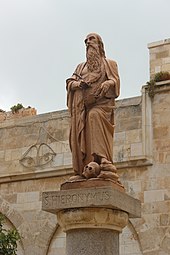 Statue of Saint Jerome (Hieronymus) – Bethlehem, Palestine Authority, West Bank
Statue of Saint Jerome (Hieronymus) – Bethlehem, Palestine Authority, West Bank
Jerome is the second most voluminous writer (after Augustine of Hippo) in ancient Latin Christianity. In the Catholic Church, he is recognized as the patron saint of translators, librarians and encyclopedists.
He acquired a knowledge of Hebrew by studying with a Jew who converted to Christianity. Against the traditional view at the time, he maintained that the Hebrew, not the Septuagint, was the inspired text of the Old Testament. Over a period of fifteen years at the request of Pope Damasus, he made a translation from the Hebrew into Latin that eventually superseded the preceding Latin translations and became known as the Vulgate. In the Council of Trent, it was declared authoritative "in public lectures, disputations, sermons and expositions".
Jerome showed more zeal and interest in the ascetic ideal than in abstract speculation. He lived as an ascetic for four or five years in the Syrian desert and later, for 34 years, near Bethlehem. Nevertheless, his writings show outstanding scholarship and his correspondence is historically of great importance.
It was Jerome's strict asceticism that made Martin Luther judge him so severely. In fact, Protestant readers are not generally inclined to accept his writings as authoritative. The tendency to recognize a superior comes out in his correspondence with Augustine (cf. Jerome's letters numbered 56, 67, 102–105, 110–112, 115–116; and 28, 39, 40, 67–68, 71–75, 81–82 in Augustine's).
Jerome is remembered in the Church of England with a commemoration on 30 September.
In art
 Saint Hieronymus (1978), by Jose Escada
Saint Hieronymus (1978), by Jose Escada
In art, Jerome is often represented as one of the four Latin doctors of the Church along with Augustine of Hippo, Ambrose, and Pope Gregory I. As a prominent member of the Roman clergy, he has often been portrayed anachronistically in the garb of a cardinal. Even when he is depicted as a half-clad anchorite, with cross, skull and Bible for the only furniture of his cell, the red hat or some other indication of his rank as cardinal is as a rule introduced somewhere in the picture. During Jerome's life, cardinals did not exist. However, by the time of the Renaissance and the Baroque it was common practice for a secretary to the pope to be a cardinal (as Jerome had effectively been to Damasus), and so this was reflected in artistic interpretations.
Jerome is also often depicted with a lion, in reference to the popular hagiographical belief that Jerome had tamed a lion in the wilderness by healing its paw. The source for the story may actually have been the second century Roman tale of Androcles, or confusion with the exploits of Saint Gerasimus (Jerome in later Latin is "Geronimus"). Hagiographies of Jerome talk of his having spent many years in the Syrian desert, and artists often depict him in a "wilderness", which for West European painters can take the form of a wood.
From the late Middle Ages, depictions of Jerome in a wider setting became popular. He is either shown in his study, surrounded by books and the equipment of a scholar, or in a rocky desert, or in a setting that combines both aspects, with him studying a book under the shelter of a rock-face or cave mouth. His study is often shown as large and well-provided for, he is often clean-shaven and well-dressed, and a cardinal's hat may appear. These images derive from the tradition of the evangelist portrait, though Jerome is often given the library and desk of a serious scholar. His attribute of the lion, often shown at a smaller scale, may be beside him in either setting. The subject of "Jerome Penitent" first appears in the later 15th century in Italy; he is usually in the desert, wearing ragged clothes, and often naked above the waist. His gaze is usually fixed on a crucifix and he may beat himself with his fist or a rock.
Jerome is often depicted in connection with the vanitas motif, the reflection on the meaninglessness of earthly life and the transient nature of all earthly goods and pursuits. In the 16th century Saint Jerome in his study by Pieter Coecke van Aelst and workshop, the saint is depicted with a skull. Behind him on the wall is pinned an admonition, Cogita Mori ("Think upon death"). Further reminders of the vanitas motif of the passage of time and the imminence of death are the image of the Last Judgment visible in the saint's Bible, the candle and the hourglass.
Jerome is also sometimes depicted with an owl, the symbol of wisdom and scholarship. Writing materials and the trumpet of final judgment are also part of his iconography. He is commemorated on 30 September with a memorial.
-
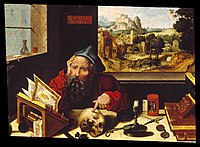
Saint Jerome in his study, c. 1530 by Pieter Coecke van Aelst and Workshop, Walters Art Museum
-
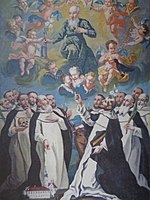
Saint Jerome and the Paulines painted by Gabriel Thaller in the St. Jerome Church in Štrigova, Međimurje County, northern Croatia (18th century)
-
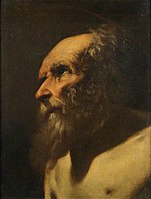
Saint Jerome by Simon Vouet c. 1620
-

Saint Jerome c. 1520 Netherlandish stained glass window at MET.





